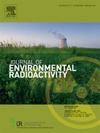铍-7浓度与东北季风活动动态关系的系统研究
IF 2.1
3区 环境科学与生态学
Q3 ENVIRONMENTAL SCIENCES
引用次数: 0
摘要
《全面禁止核试验条约》(全面禁试条约)建立的几个放射性核素站为系统研究环境应用中的铍-7浓度提供了独特的机会。这些气象站位于东北季风季节的风路沿线。这些台站也探测到宇宙形成的放射性核素Be-7,它是大气过程,特别是受季风模式影响的降水动力学的示踪剂。本研究探讨了Be-7浓度与马来西亚东北季风期间两类浪涌的相关性,即东风浪涌和经向浪涌。东北季风是东南亚的一个重要气候现象,影响着区域的天气模式和降水水平。了解Be-7浓度与这两次暴增之间的关系,可以深入了解大气输送机制、降雨变率以及对气候和环境研究的潜在影响。运用Granger因果检验检验了Be-7浓度与经向浪涌(MS)和东风浪涌(ES)指数所代表的关键季风动力学之间的关系。在几个放射性核素站发现了显著的预测滞后(2-11天),表明Be-7有可能成为季风降雨时间和强度的领先指标。这些结果与现有证据一致,即Be-7浓度受湿度、干燥度和降水等大气因素的影响。本文章由计算机程序翻译,如有差异,请以英文原文为准。
Systematic study on the relationship between Beryllium-7 concentration with dynamics of northeast monsoon activity
Several radionuclide stations established by the Comprehensive Nuclear Test-ban Treaty (CTBT) have provided a unique opportunity for systematic study in the investigation of Beryllium-7 (Be-7) concentration for environmental applications. These stations are located along wind pathways during the Northeast Monsoon season. The cosmogenic radionuclide Be-7, also detected by these stations, serves as a tracer for atmospheric processes, particularly precipitation dynamics influenced by monsoonal patterns. This research explores the correlation between Be-7 concentration and the two types of surges during the Northeast Monsoon in Malaysia, encompassing Easterly (ES) and Meridional surges (MS). The Northeast Monsoon, a significant climatic phenomenon in Southeast Asia, impacts regional weather patterns and precipitation levels. Understanding the correlation between Be-7 concentration and these two surges could provide insights into atmospheric transport mechanisms, rainfall variability, and potential implications for climate and environmental studies. The Granger Causality test is applied to examine the relationship between Be-7 concentration and key monsoonal dynamics represented by the Meridional Surge (MS) and Easterly Surge (ES) indices. Significant predictive lags (2–11 days) are identified at several radionuclide stations, indicating Be-7's potential as a leading indicator of monsoonal rainfall timing and intensity. These results align with existing evidence that Be-7 concentrations are influenced by atmospheric factors such as humidity, dryness, and precipitation.
求助全文
通过发布文献求助,成功后即可免费获取论文全文。
去求助
来源期刊

Journal of environmental radioactivity
环境科学-环境科学
CiteScore
4.70
自引率
13.00%
发文量
209
审稿时长
73 days
期刊介绍:
The Journal of Environmental Radioactivity provides a coherent international forum for publication of original research or review papers on any aspect of the occurrence of radioactivity in natural systems.
Relevant subject areas range from applications of environmental radionuclides as mechanistic or timescale tracers of natural processes to assessments of the radioecological or radiological effects of ambient radioactivity. Papers deal with naturally occurring nuclides or with those created and released by man through nuclear weapons manufacture and testing, energy production, fuel-cycle technology, etc. Reports on radioactivity in the oceans, sediments, rivers, lakes, groundwaters, soils, atmosphere and all divisions of the biosphere are welcomed, but these should not simply be of a monitoring nature unless the data are particularly innovative.
 求助内容:
求助内容: 应助结果提醒方式:
应助结果提醒方式:


